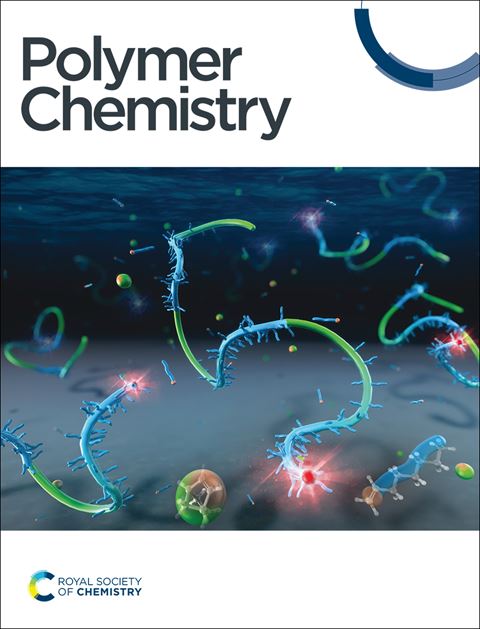动态阳离子开关聚合制备乙烯和丙烯酸烷基酯共聚物及低极性基团密度下聚合物可降解性改善的证据
IF 3.9
2区 化学
Q2 POLYMER SCIENCE
引用次数: 0
摘要
功能聚烯烃的工业合成依赖于自由基聚合,这需要高温高压,并且微观结构控制不好。在此,我们报告了一种阳离子开关策略来获得乙烯和丙烯酸烷基酯共聚物,其分子量、分子量分布和极性单体密度在催化剂依赖范围内可调。这种精度是通过利用我们的镍苯氧膦-聚乙二醇催化剂在M+和M ' +(其中M+, M ' + = Li+, Na+, K+或Cs+, M≠M ')之间的阳离子交换动力学实现的。在非开关条件下,使用镍催化剂在M+和M ' +盐的存在下,乙烯和丙烯酸甲酯(MA)共聚得到了基于M+:M ' +比例可调节分子量分布的乙烯-丙烯酸甲酯共聚物(EMA)。在动态阳离子开关条件下,该催化剂体系产生了分子量和MA掺入量可以独立变化的单模态EMA。EMA的研究表明,虽然它们保留了相同分子量的聚乙烯的热性能和机械性能,但每条链增加1-3个单位的MA会导致它们的润湿性和对氧化裂解的敏感性显著增加。这项工作增加了越来越多的证据,表明乙烯基材料可以在不影响其性能的情况下设计成更好的可降解性。本文章由计算机程序翻译,如有差异,请以英文原文为准。
Ethylene and Alkyl Acrylate Copolymers Made-to-Order Using Dynamic Cation Switching Polymerization and Evidence for Improved Polymer Degradability with Low Polar Group Density
The industrial synthesis of functional polyolefins relies on free radical polymerization, which requires high temperature and pressure and offers poor microstructure control. Herein, we report a cation-switching strategy to access ethylene and alkyl acrylate copolymers with made-to-order molecular weight, molecular weight distribution, and polar monomer density, tunable within a catalyst-dependent range. This precision was achieved by exploiting the cation exchange dynamics between M+ and M′+ (where M+, M′+ = Li+, Na+, K+, or Cs+, and M ≠ M′) with our nickel phenoxyphosphine-polyethylene glycol catalyst. Under non-switching conditions, copolymerization of ethylene and methyl acrylate (MA) using our nickel catalyst in the presence of M+ and M′+ salts afforded ethylene-MA copolymers (EMA) with adjustable molecular weight distributions based on the ratio of M+:M′+ employed. Under dynamic cation switching conditions, this catalyst system yielded monomodal EMA with molecular weight and MA incorporation that can be varied independently. Studies of the EMA revealed that while they retain the thermal and mechanical properties of polyethylene having the same molecular weight, increasing the MA per chain by as few as 1-3 units leads to measurable increase in their wettability and susceptibility toward oxidative cleavage. This work adds to a growing body of evidence suggesting that ethylene-based materials can be designed for improved degradability without compromising their performance.
求助全文
通过发布文献求助,成功后即可免费获取论文全文。
去求助
来源期刊

Polymer Chemistry
POLYMER SCIENCE-
CiteScore
8.60
自引率
8.70%
发文量
535
审稿时长
1.7 months
期刊介绍:
Polymer Chemistry welcomes submissions in all areas of polymer science that have a strong focus on macromolecular chemistry. Manuscripts may cover a broad range of fields, yet no direct application focus is required.
 求助内容:
求助内容: 应助结果提醒方式:
应助结果提醒方式:


